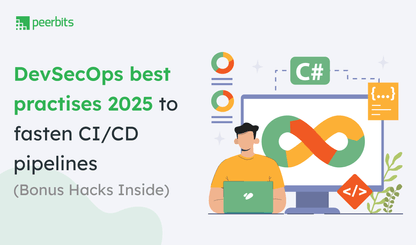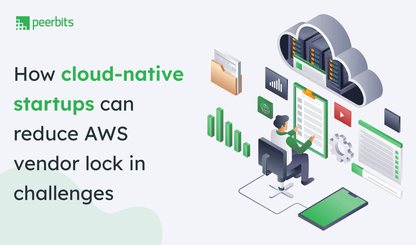Delayed software releases, system failures, and security gaps can cost businesses more than just revenue—they risk losing customer trust. DevOps helps companies avoid these issues by automating workflows, improving collaboration, and ensuring faster, more reliable deployments. With businesses prioritizing efficiency, the DevOps market is projected to reach $25.5 billion by 2028, according to Markets and Markets.
From DevOps consulting services for startups aiming for agility to DevOps for enterprise, managing large-scale operations, the benefits are clear. Automated pipelines, real-time monitoring, and built-in security help companies reduce downtime, speed up releases, and optimize resources without unnecessary overhead.
Modern trends like AI in DevOps, serverless computing and DevOps, and security automation are changing how businesses develop and deploy software. AI enhances predictive monitoring, serverless models simplify deployments, and security is no longer an afterthought—it’s integrated from the start.
This guide explores the principles of DevOps, the working process, and real-world DevOps workflow examples. Whether you're adopting DevOps for the first time or refining your strategy, this will serve as a complete roadmap.
DevOps principles and key practices
DevOps helps businesses accelerate software delivery, improve reliability, and strengthen security by following structured principles and practices. These guide how teams collaborate, automate processes, and maintain continuous feedback to keep systems running efficiently.
Core principles of DevOps
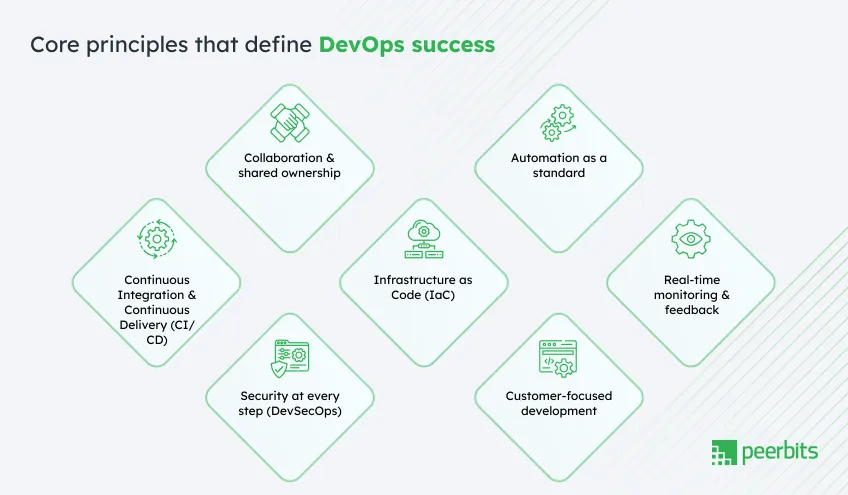
These seven principles define the philosophy behind DevOps practices and principles and shape how businesses apply them:
1. Collaboration & shared ownership: Development, operations, and security teams work together instead of operating in silos. Shared accountability improves problem-solving and speeds up issue resolution.
2. Automation as a standard: Manual tasks slow down releases and introduce errors. Automation in testing, deployment, and infrastructure management ensures consistency and efficiency.
3. Continuous Integration & Continuous Delivery (CI/CD): Developers frequently integrate code into a shared repository, allowing automated testing and seamless deployments. This ensures faster releases with fewer failures.
4. Infrastructure as Code (IaC): Instead of manually configuring servers, teams define infrastructure using code, making it easy to replicate, modify, and scale environments quickly.
5. Real-time monitoring & feedback: Constant tracking of performance, logs, and metrics helps teams detect and fix issues early, preventing downtime and improving system stability.
6. Security at every step (DevSecOps): Security is built into every stage of development, from code scanning to automated compliance checks, reducing vulnerabilities before deployment.
7. Customer-focused development: Continuous feedback from users ensures that software is aligned with business needs, delivering real value instead of just frequent updates.
These principles guide how businesses implement DevOps services and solutions, ensuring a smooth and scalable software lifecycle.
Essential DevOps practices used in businesses
These key DevOps practices help organizations optimize software development and deployment:
- Collaboration across teams: Developers, IT operations, and security teams work together from the start, reducing bottlenecks and improving communication.
- Automated workflows: Routine processes like code testing, deployment, and infrastructure setup are automated, reducing errors and increasing speed.
- CI/CD pipelines: Automated testing and integration allow teams to release updates frequently and reliably, reducing risks associated with large deployments.
- Infrastructure as Code (IaC): Infrastructure is defined in code, allowing teams to deploy environments instantly and maintain consistency across different setups.
- Monitoring & logging: Continuous tracking of system health, performance, and security logs helps detect and resolve issues before they impact users.
- Microservices & containerization: Applications are broken into smaller, independent services, making scaling easier and reducing dependency risks.
- Serverless computing: Businesses can deploy applications without managing physical or virtual servers, cutting costs and improving efficiency.
- AI-driven DevOps (AIOps): AI is used for log analysis, anomaly detection, and performance monitoring, helping teams proactively fix issues.
- Version control & rollback strategies: Every change is tracked, allowing teams to quickly revert updates if something goes wrong, reducing downtime.
- Security & compliance (DevSecOps): Security is integrated into every phase, ensuring compliance with industry regulations and reducing risks.
These DevOps practices and principles create a strong foundation for automation, collaboration, and scalability, helping businesses improve efficiency and minimize risks.

How DevOps works?
DevOps creates a collaborative environment where development and operations teams work together to streamline software delivery. Instead of isolated workflows, everything is integrated into a continuous process, ensuring that software is built, tested, and deployed efficiently.
The working process of DevOps follows a structured lifecycle, but with advancements like AI and serverless computing, traditional workflows are evolving to be more automated, intelligent, and scalable.
The DevOps lifecycle
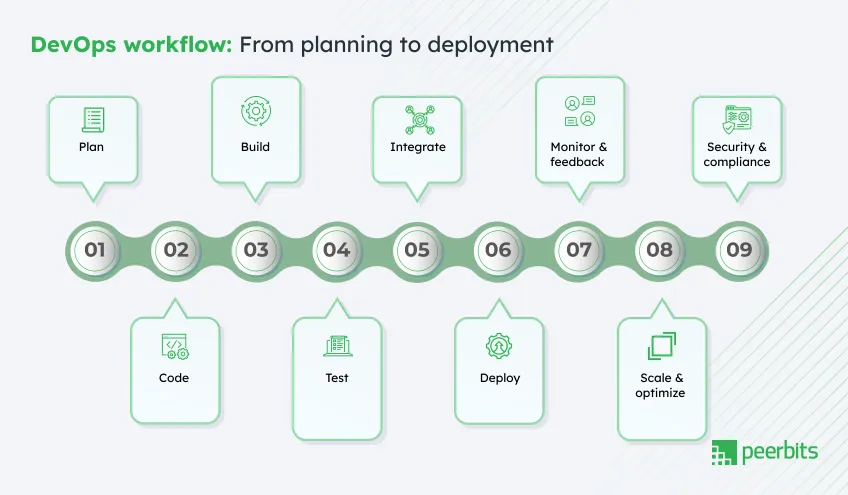
The DevOps lifecycle covers everything from planning and coding to monitoring and scaling applications. While traditional workflows focused on manual processes, AI and serverless computing are now making DevOps faster and more efficient.
- Traditional DevOps workflows: Teams manually set up infrastructure, monitor performance, and handle deployments, requiring significant time and resources.
- AI in DevOps: AI-powered tools predict failures, automate issue resolution, and optimize workflows based on real-time data.
- Serverless computing in DevOps: Businesses deploy software without managing infrastructure, making CI/CD pipelines faster and reducing operational overhead.
These advancements are reshaping how DevOps works, making it more adaptive to modern business needs.
Breaking down each stage in detail
Each stage of the DevOps lifecycle contributes to efficient software delivery while maintaining security and scalability.
- Plan: Business goals are aligned with development strategies. Teams define requirements, set timelines, and prepare for implementation.
- Code: Developers write, review, and manage code using version control systems like Git, ensuring smooth collaboration.
- Build: Source code is converted into executable applications, with automated tools handling dependencies and packaging.
- Test: Automated testing checks for bugs, security vulnerabilities, and performance issues before deployment.
- Integrate: New code is merged into a shared repository, validated, and tested automatically to avoid integration conflicts.
- Deploy: Applications are released efficiently, either through traditional infrastructure or serverless CI/CD pipelines for faster rollouts.
- Monitor & feedback: Performance is tracked using real-time monitoring tools, and feedback loops help teams improve future releases.
- Scale & optimize: Applications adapt to business growth, automatically scaling resources to meet demand.
- Security & compliance: Security is embedded in every phase, reducing risks and ensuring compliance with regulations.
Additional advancements shaping modern DevOps workflows:
- AI-driven automation: AI-powered insights detect anomalies, suggest fixes, and optimize resource allocation, reducing manual intervention.
- Serverless CI/CD pipelines: Deployments happen without managing infrastructure, reducing complexity and improving speed.
This structured DevOps lifecycle helps businesses achieve continuous delivery, reduce downtime, and maintain system security with modern tools.
Read more: How can DevOps automation with AWS-CDK help in business expansion?
How businesses benefit from DevOps?
DevOps is not just a methodology—it’s a game-changer for businesses looking to scale, innovate, and stay competitive. By combining automation, collaboration, and continuous feedback, companies optimize software delivery while reducing costs and risks. Here’s how DevOps drives real results:
- Faster time-to-market: Automated pipelines and CI/CD workflows accelerate software releases, enabling businesses to push updates faster.
- Reduced manual errors: Automated testing and deployment minimize human errors, ensuring stable and reliable releases.
- Improved collaboration: Dev and Ops teams work together with shared ownership, eliminating bottlenecks and improving efficiency.
- Efficient resource utilization: Cloud-based infrastructure and containerization help optimize costs, preventing over-provisioning.
- Enhanced scalability: Applications automatically scale based on demand, ensuring uninterrupted user experience during traffic spikes.
- Reduced downtime: Proactive monitoring and self-healing systems detect and fix issues before they impact users.
- Continuous feedback loop: Real-time data from monitoring tools drives iterative improvements, making software more reliable over time.
- Security integration: DevSecOps embeds security early in the pipeline, reducing vulnerabilities and ensuring compliance with industry standards.
- Rapid innovation: Shorter development cycles allow teams to experiment, iterate, and roll out features faster, keeping businesses ahead of competitors.
- Culture of continuous improvement: DevOps promotes long-term efficiency by encouraging teams to refine processes, tools, and workflows continuously.
Businesses across industries—from startups to enterprises—adopt DevOps to boost agility, cut costs, and maintain a competitive edge in a fast-evolving market.
Challenges in DevOps adoption
Adopting DevOps brings significant business benefits, but it’s not without its challenges. Companies often struggle with culture shifts, technical complexities, and security concerns while integrating DevOps into their workflows. Here are some of the biggest hurdles businesses face: Adopting DevOps brings significant business benefits, but it’s not without its challenges. Companies often struggle with culture shifts, technical complexities, and security concerns while integrating DevOps into their workflows. Here are some of the biggest hurdles businesses face:
- Cultural shift: Many teams resist breaking silos between development and operations, making collaboration difficult.
- Skillset gap: DevOps requires expertise in automation, cloud infrastructure, and modern DevOps tools, which not all teams possess.
- Tool complexity: Managing multiple CI/CD pipelines, monitoring tools, and container orchestration platforms can create integration challenges.
- Legacy systems: Many enterprises struggle to integrate older infrastructure with modern DevOps practices, slowing down transformation.
- Security and compliance: Balancing speed and security is difficult, especially when meeting compliance regulations like GDPR and HIPAA.
- Resistance to change: Shifting to a DevOps-driven culture can face pushback from leadership and teams accustomed to traditional workflows.
- AI ethics and bias in DevOps (AIOps challenges): AI-driven DevOps introduces concerns about transparency, fairness, and potential bias in automation.
- Continuous compliance updates: Regulatory changes require frequent security updates, increasing operational workload.
- Scalability challenges with AI & serverless: While AI and serverless computing optimize DevOps workflows, unpredictable workloads complicate resource management.
Overcoming these challenges requires proper training, strategic tool selection, and a shift in company mindset. Businesses that successfully navigate these hurdles gain faster deployments, improved collaboration, and stronger security in their DevOps journey.
How to get started with DevOps?
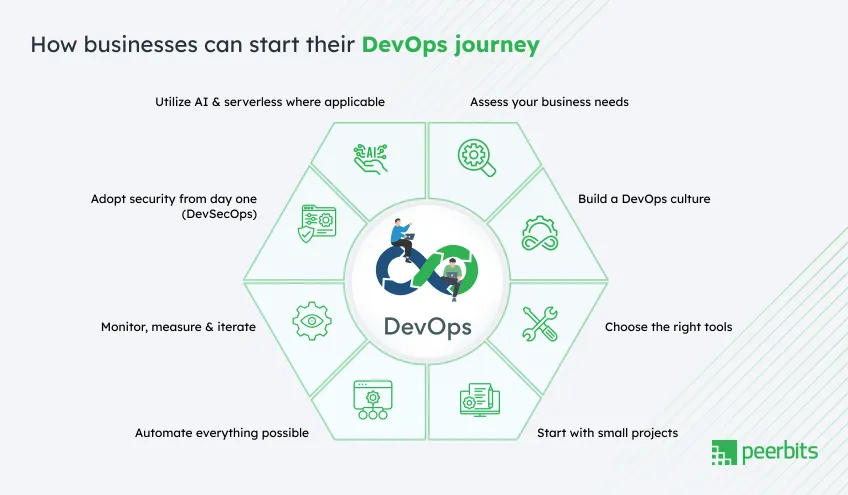
Shifting to DevOps practices and principles requires careful planning and the right strategy. Businesses that rush into adoption without a clear roadmap often face setbacks. Here’s how to start your DevOps journey effectively:
- Assess your business needs: Identify pain points, bottlenecks, and goals to understand how DevOps can bring business benefits.
- Build a DevOps culture: Encourage collaboration, transparency, and shared ownership across development, operations, and security teams.
- Choose the right tools: Invest in CI/CD pipelines, automation platforms, cloud-native solutions, and monitoring tools that fit your workflow.
- Start with small projects: Implement DevOps in phases to test workflows, gather insights, and refine processes before scaling.
- Automate everything possible: Reduce manual errors by automating testing, deployments, infrastructure provisioning, and monitoring.
- Monitor, measure & iterate: Use real-time monitoring, logging, and performance analytics to continuously refine DevOps workflows.
- Adopt security from day one (DevSecOps): Integrate security and compliance checks early to prevent vulnerabilities instead of fixing them later.
- Utilize AI & serverless where applicable: Use AI-driven monitoring and serverless architectures to optimize resource management and scalability.
Starting with the right mindset and a step-by-step approach helps businesses successfully integrate DevOps workflows while minimizing risks. As teams become more familiar with DevOps practices, they can expand adoption across the organization for greater efficiency and faster innovation.
Conclusion
DevOps has redefined how businesses build, test, and deploy software. Companies that apply DevOps practices and principles achieve faster releases, improved collaboration, and better resource management, helping them stay efficient and adaptable.
The rise of AI, automation, and serverless computing is shaping the next phase of DevOps, making workflows smarter and more scalable. While challenges like compliance updates, tool complexity, and skill gaps exist, a structured strategy can help businesses overcome them.
Adopting DevOps services and solutions isn’t just about improving processes—it’s about staying prepared for changing market demands. The sooner businesses start, the better positioned they’ll be for long-term growth.


